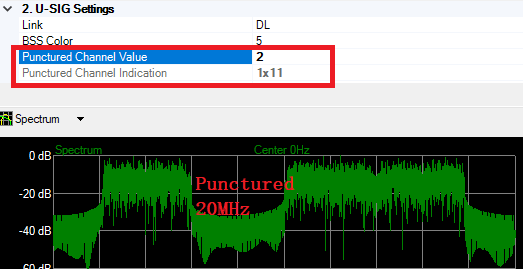
IEEE 802.11be supporting a maximum throughput of at least 30 Gbps, as measured at the MAC data service access point (SAP), with carrier frequency operation between 1 and 7.250 GHz while ensuring backward compatibility and coexistence with legacy IEEE Std 802.11 compliant devices operating in the 2.4 GHz, 5 GHz, and 6 GHz bands.
The following features are supported:
Three generation modes: EHT MU PPDU, Non-HT, EHT Trigger Based PPDU
Five Bandwidth types: 20 MHz, 40 MHz, 80 MHz, 160 MHz, 320 MHz
Up to 8 spatial streams
MCS index: MCSs 0 to 15
Binary convolutional coding
Low Density Parity Check (LDPC)
The format of the EHT MU PPDU is defined as in Figure 1 (EHT MU PPDU format). This PPDU format is used for MU (Non-OFDMA and OFDMA) transmission.

Figure 1. EHT MU PPDU Format
The format of the EHT trigger-based PPDU is defined as in Figure 2 (EHT trigger-based PPDU format). This format is used for a transmission that is a response to a Trigger frame.

Figure 2. EHT Trigger-Based PPDU Format
For the 80 MHz, 160 MHz and 320 MHz PPDU, there can be punctured channels which are indicated by the “Punctured Channel Value.” The mapping of the “Punctured Channel Value” to the non-OFDMA puncturing pattern is showing below:
|
PPDU BW |
Cases |
Value |
|
|---|---|---|---|
|
80 MHz |
No puncturing |
[1 1 1 1] |
0 |
|
20 MHz punctured |
[x 1 1 1] |
1 |
|
|
[1 x 1 1] |
2 |
||
|
[1 1 x 1] |
3 |
||
|
[1 1 1 x] |
4 |
||
|
160 MHz |
No puncturing |
[1 1 1 1 1 1 1 1] |
0 |
|
20 MHz punctured |
[x 1 1 1 1 1 1 1] |
1 |
|
|
[1 x 1 1 1 1 1 1] |
2 |
||
|
[1 1 x 1 1 1 1 1] |
3 |
||
|
[1 1 1 x 1 1 1 1] |
4 |
||
|
[1 1 1 1 x 1 1 1] |
5 |
||
|
[1 1 1 1 1 x 1 1] |
6 |
||
|
[1 1 1 1 1 1 x 1] |
7 |
||
|
[1 1 1 1 1 1 1 x] |
8 |
||
|
40 MHz punctured |
[x x 1 1 1 1 1 1] |
9 |
|
|
[1 1 x x 1 1 1 1] |
10 |
||
|
[1 1 1 1 x x 1 1] |
11 |
||
|
[1 1 1 1 1 1 x x] |
12 |
||
|
320 MHz
|
No puncturing |
[1 1 1 1 1 1 1 1] |
0 |
|
40 MHz punctured |
[x 1 1 1 1 1 1 1] |
1 |
|
|
[1 x 1 1 1 1 1 1] |
2 |
||
|
[1 1 x 1 1 1 1 1] |
3 |
||
|
[1 1 1 x 1 1 1 1] |
4 |
||
|
[1 1 1 1 x 1 1 1] |
5 |
||
|
[1 1 1 1 1 x 1 1] |
6 |
||
|
[1 1 1 1 1 1 x 1] |
7 |
||
|
[1 1 1 1 1 1 1 x] |
8 |
||
|
80 MHz punctured |
[x x 1 1 1 1 1 1] |
9 |
|
|
[1 1 x x 1 1 1 1] |
10 |
||
|
[1 1 1 1 x x 1 1] |
11 |
||
|
[1 1 1 1 1 1 x x] |
12 |
||
|
320-80-40 |
[x x x 1 1 1 1 1] |
13 |
|
|
[x x 1 x 1 1 1 1] |
14 |
||
|
[x x 1 1 x 1 1 1] |
15 |
||
|
[x x 1 1 1 x 1 1] |
16 |
||
|
[x x 1 1 1 1 x 1] |
17 |
||
|
[x x 1 1 1 1 1 x] |
18 |
||
|
[x 1 1 1 1 1 x x] |
19 |
||
|
[1 x 1 1 1 1 x x] |
20 |
||
|
[1 1 x 1 1 1 x x] |
21 |
||
|
[1 1 1 x 1 1 x x] |
22 |
||
|
[1 1 1 1 x 1 x x] |
23 |
||
|
[1 1 1 1 1 x x x] |
24 |
Below is an example for 80 MHz bandwidth PPDU with Punctured Channel Value of 2.
